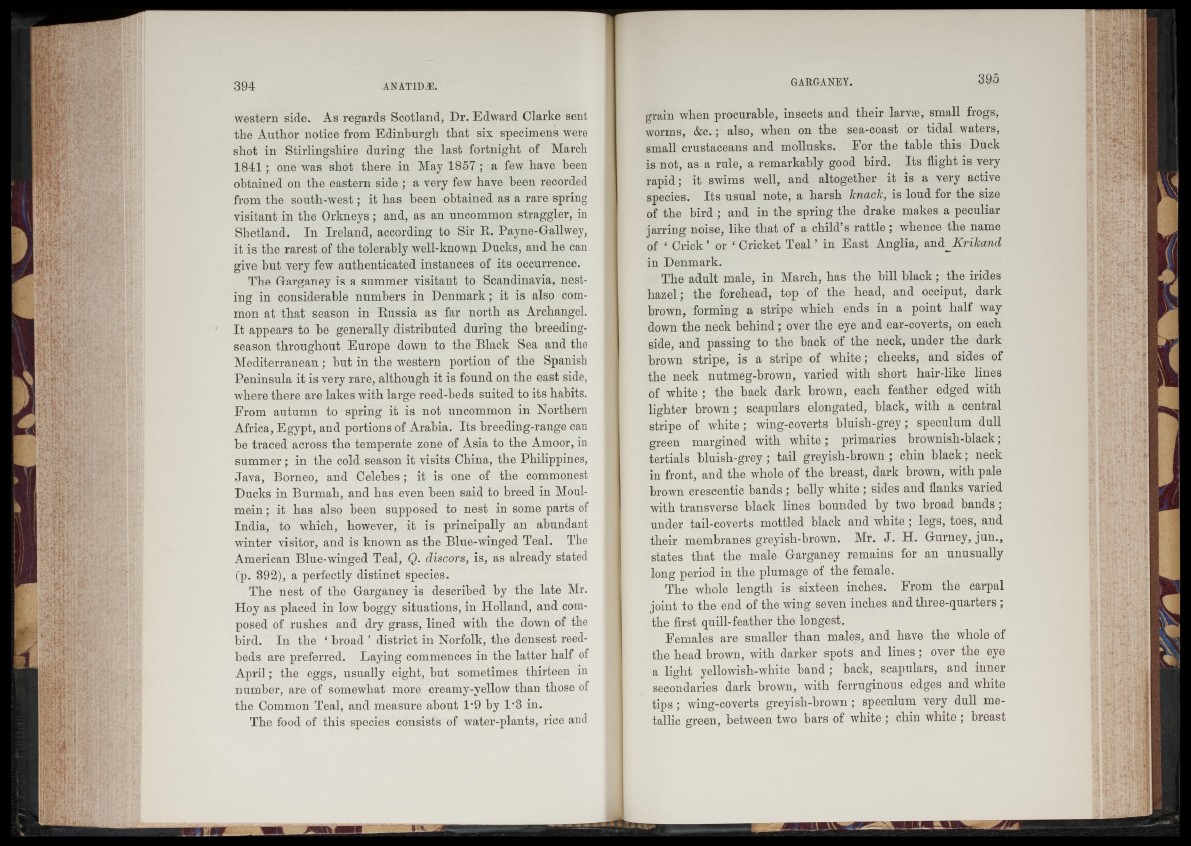
western side. As regards Scotland, Dr. Edward Clarke sent
the Author notice from Edinburgh that six specimens were
shot in Stirlingshire during the last fortnight of March
1841 ; one was shot there in May 1857; a few have been
obtained on the eastern side ; a very few have been recorded
from the south-west; it has been obtained as a rare spring
visitant in the Orkneys ; and, as an uncommon straggler, in
Shetland. In Ireland, according to Sir E. Payne-Gallwey,
it is the rarest of the tolerably well-known Ducks, and he can
give but very few authenticated instances of its occurrence.
The Garganey is a summer visitant to Scandinavia, nesting
in considerable numbers in Denmark; it is also common
at that season in Russia as far north as Archangel.
It appears to be generally distributed during the breeding-
season throughout Europe down to the Black Sea and the
Mediterranean; hut in the western portion of the Spanish
Peninsula it is very rare, although it is found on the east side,
where there are lakes with large reed-beds suited to its habits.
From autumn to spring it is not uncommon in Northern
Africa, Egypt, and portions of Arabia. Its breeding-range can
be traced across the temperate zone of Asia to the Amoor, in
summer; in the cold season it visits China, the Philippines,
Java, Borneo, and Celebes ; it is one of the commonest
Ducks in Burmah, and has even been said to breed in Moul-
mein; it has also been supposed to nest in some parts of
India, to which, however, it is principally an abundant
winter visitor, and is known as the Blue-winged Teal. The
American Blue-winged Teal, Q. discors, is, as already stated
(p. 892), a perfectly distinct species.
The nest of the Garganey is described by the late Mr.
Hoy as placed in low boggy situations, in Holland, and composed
of rushes and dry grass, lined with the down of the
bird. In the £ broad ’ district in Norfolk, the densest reed-
beds are preferred. Laying commences in the latter half of
April; the eggs, usually eight, but sometimes thirteen in
number, are of somewhat more creamy-yellow than those of
the Common Teal, and measure about 1*9 by l ’B in.
The food of this species consists of water-plants, rice and
grain when procurable, insects and their larvae, small frogs,
worms, &c.; also, when on the sea-coast or tidal waters,
small crustaceans and mollusks. For the table this Duck
is not, as a rule, a remarkably good bird. Its flight is very
rapid; it swims well, and altogether it is a very active
species. Its usual note, a harsh knack, is loud for the size
of the bird ; and in the spring the drake makes a peculiar
jarring noise, like that of a child’s rattle ; whence the name
of ‘ Crick ’ or ‘ Cricket Teal ’ in East Anglia, sm&^Krikand
in Denmark.
The adult male, in March, has the bill black ; the hides
hazel; the forehead, top of the head, and occiput, dark
brown, forming a stripe which ends in a point half way
down the neck behind; over the eye and ear-coverts, on each
side, and passing to the back of the neck, under the dark
brown stripe, is a stripe of white; cheeks, and sides of
the neck nutmeg-brown, varied with short hair-like lines
of white ; the back dark brown, each feather edged with
lighter brown ; scapulars elongated, black, with a central
stripe of white ; wing-coverts bluish-grey; speculum dull
green margined with white; primaries brownish-black,
tertials bluish-grey ; tail greyish-brown ; chin black; neck
in front, and the whole of the breast, dark brown, with pale
brown crescentic bands ; belly white ; sides and flanks varied
with transverse black lines bounded by two broad bands ;
under tail-coverts mottled black and white ; legs, toes, and
their membranes greyish-brown. Mr. J. H. Gurney, jun.,
states that the male Garganey remains for an unusually
long period in the plumage of the female.
The wdiole length is sixteen inches. From the carpal
joint to the end of the wing seven inches and three-quarters ;
the first quill-feather the longest.
Females are smaller than males, and have the whole of
the head brown, with darker spots and lines ; over the eye
a light yellowish-white band; back, scapulars, and inner
secondaries dark brown, with ferruginous edges and white
tips ; wing-coverts greyish-brown ; speculum very dull metallic
green, between two bars of white ; chin white ; breast